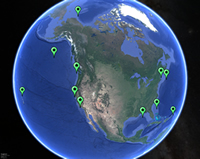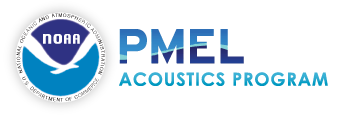 |
NOAA/NPS Ocean Noise Reference Station Network
This unique network of hydrophones is a collaborative effort between OAR’s Pacific Marine Environmental Laboratory (PMEL), all NMFS Science Centers, the NOS National Marine Sanctuary System, and the National Park Service to establish and collect consistent and comparable long-term acoustic data sets covering all major regions of the U.S.
Click here for larger globe view.
For a Google Earth view of the stations, open the kmz file here.
Background:
Passive acoustic monitoring of the ocean ambient sound field is a critical aspect of NOAA’s mandate for ocean and coastal stewardship. This includes detecting and characterizing: (1) sounds produced and used by living marine resources (e.g., endangered marine mammals); (2) natural sources of noise from physical oceanographic processes; and (3) anthropogenic noise sources that contribute to the overall ocean noise environment. Noise generated by anthropogenic activities (especially commercial shipping and seismic oil & gas exploration) is increasingly being recognized as a potential threat to marine mammals which are protected in the U.S. by the Marine Mammal Protection Act and the Endangered Species Act. Current scientific data suggest that increased ambient noise levels impact marine mammals by hindering communication (Hatch et al. 2012), altering communication behavior (Parks et al. 2013), altering locomotive behavior (Pirotta et al. 2013), and inducing stress (Rolland et al. 2012).
Additional concerns associated with the degraded acoustic quality of diverse habitats broaden these concerns to include possible repercussions for fish and invertebrate species, many of which NOAA manages as commercially-harvested, protects as resources within sanctuaries, or studies as key elements to sustaining healthy ecosystems. For these reasons it is important for science-based regulatory agencies including NOAA to monitor long-term trends and changes in the ambient sound field.
Research Objective:
The objective of the project is to establish a network of ocean noise reference stations in U.S. waters to monitor long-term changes and trends in the underwater ambient sound field (McDonald et al. 2006). The identical autonomous acoustic recording systems were developed and built in-house at PMEL to ensure proper calibration and consistency of the collected data sets. The hydrophone moorings are currently deployed in the following areas:
Deployments:
| Station | Location | Partners | Latitude | Longitude | Water depth [m] | AUH depth [m] | Initial Deployment | Most Recent Deployment |
| NRS01 | Alaskan Arctic | NOAA/AFSC | 72.44 | -156.55 | 1,000 | 500 | October 2014 | September 2015 |
| NRS02 | Gulf of Alaska | NOAA/PMEL | 50.25 | -145.13 | 4,250 | 500 | January 2015 | August 2016 |
| NRS03 | Olympic Coast National Marine Sanctuary | NOAA/NWFSC & NOAA/OCNMS | 47.77 | -125.52 | 936 | 488 | September 2014 | September 2017 |
| NRS04 | Hawaiian Islands | NOAA/PIFSC | 22.33 | -157.67 | ~4,900 | 900 | July 2015 | July 2017 |
| NRS05 | Channel Islands National Marine Sanctuary | NOAA/SWFSC | 33.9 | -119.58 | 1,000 | 900 | October 2014 | January 2018 |
| NRS06 | Gulf of America | NOAA/SEFSC | 28.25 | -86.83 | 1,230 | 900 | July 2014 | March 2018 |
| NRS07 | Southeastern continental U.S. (SE US) | NOAA/SEFSC | 29.33 | -77.99 | 870 | 900 | April 2015 | August 2017 |
| NRS08 | Northeastern continental U.S. (NE US) | NOAA/NEFSC | 39.01 | -67.27 | ~3,550 | 900 | June 2014 | June 2018 |
| NRS09 | Stellwagen Bank National Marine Sanctuary | NOAA/SBNMS | 42.4 | -70.13 | 79 | 79 | October 2014 | January 2018 |
| NRS10 | Tutuila Island, National Park of American Samoa | NPS & NPAS | -14.27 | -170.72 | 33 | 33 | June 2015 | September 2018 |
| NRS11 | Cordell Bank Coast National Marine Sanctuary | NOAA/CBNMS | 37.88 | -126.44 | 534 | 500 | October 2015 | October 2017 |
| NRS12 | Buck Island Reef National Monument, U.S. Virgin Islands (US VI) | NOAA & NPS | 17.79 | -64.65 | 40 | 40 | November 2016 | May 2018 |
It is of critical importance to continue these baseline measurements so we can establish as long a time series as possible to gauge the changes induced by anthropogenic and climate stressors on the marine ambient sound environment (for a summary see Hildebrand 2009). We will investigate the spatio-temporal variability in low-frequency deep ocean ambient sound levels (10 - 2,200 Hz) at these 12 ocean regions within the U.S. EEZ. Our ongoing goal is to maintain (and possibly expand) the array and build a multi-year record of ambient sound levels in these regions. We will then be able to identify and delineate seasonal and long-term man-made and climate-induced noise sources.
Investigators:
| Robert P. Dziak, Joe Haxel, Samara Haver, Haru Matsumoto, David K. Mellinger NOAA/PMEL Acoustics/CIMRS 2115 SE OSU Drive Newport, OR 97365 |
Joe Haxel@noaa.gov |
| Holger Klinck Bioacoustics Research Program, Cornell Lab of Ornithology, Cornell University 159 Sapsucker Woods Road, Ithaca, NY 14850, USA |
Holger.Klinck@cornell.edu |
| Jay Barlow NOAA/SWFSC 8901 La Jolla Shores Drive La Jolla, CA 92037 Jay.Barlow@noaa.gov |
Catherine Berchok NOAA/AFSC 7600 Sand Point Way NE Seattle, WA 98115 Catherine.Berchok@noaa.gov |
| Brad Hanson, Marla Holt NOAA/NWFSC 2725 Montlake Boulevard East Seattle, WA 98112 Brad.Hanson@noaa.gov Marla.Holt@noaa.gov |
Leila Hatch Stellwagen Bank National Marine Sanctuary 175 Edward Foster Road Scituate, MA 02066 Leila.Hatch@noaa.gov |
| Christian Meinig NOAA/PMEL-EDD 7600 Sand Point Way NE Seattle, WA 98115 Christian.Meinig@noaa.gov |
Erin Oleson NOAA/PIFSC 1601 Kapiolani Boulevard Honolulu, HI 96814 Erin.Oleson@noaa.gov |
| Melissa Soldevilla NOAAA/SEFSC 75 Virginia Beach Drive Miami, FL 33149 Melissa.Soldevilla@noaa.gov |
Sofie Van Parijs NOAA/NEFSC 166 Water Street Woods Hole, MA 02543 Sofie.VanParijs@noaa.gov |
| Jason Gedamke Office of Science and Technology, NOAA Fisheries 1315 East West Highway, Silver Spring, MD 20910, USA jason.gedamke@noaa.gov |
Megan F. McKenna, Eva DiDonato National Park Service Natural Sounds and Night Skies Division 1201 Oakridge Drive, Suite 100 Fort Collins, CO 80525, USA megan_f_mckenna@nps.gov, eva_didonato@nps.gov |
Danielle Lipski Cordell Bank National Marine Sanctuary 1 Bear Valley Road, Point Reyes Station, CA 94956, USA danielle.lipski@noaa.gov |
Sue E. Moore NOAA NMFS/Office of Science and Technology 7600 Sand Point Way NE, Seattle, WA 98115, USA sue.moore@noaa.gov |
References:
Hatch, L.T., Clark, C.W., Van Parijs, S.M., Frankel, A.S., and Ponirakis D.W. (2012): Quantifying loss of acoustic communication space for right whales in and around a U.S. National Marine Sanctuary. Conservation Biology, 26:983-994.
Hildebrand, J.A. (2009): Anthropogenic and natural sources of ambient noise in the ocean. Marine Ecology Progress Series, 395:5-20.
McDonald, M.A., Hildebrand, J.A., and Wiggins, S. M. (2006): Increase in deep ocean ambient noise in the Northeast Pacific west of San Nicolas Island, California. Journal of the Acoustical Society of America, 1520:711-718.
Porter, M., and Henderson, L. (2013): Global ocean soundscapes. Proceedings of Meetings on Acoustics, 19:010050 (6 pages).
Parks, S.E., Johnson, M.P., Nowacek, D.P., and Tyack, P.L. (2012): Changes in Vocal Behavior of North Atlantic Right Whales in Increased Noise. In: The Effects of Noise on Aquatic Life, Popper, A.N., Hawkins, A. eds., Springer, pp. 317-320.
Pirotta, E., Milor, R., Moretti, D., Di Marzio, N., Tyack, P.L., and Hastie, G. (2013): Vessel Noise Affects Beaked Whale Behavior: Results of a Dedicated Acoustic Response Study. PLoS ONE, 7(8):e42535.
Rolland, R.M., Parks, S.E., Hunt, K.E., Castellote, M., Corkeron, P.J., Nowacek, D.P., Wasser, S.K., and Kraus, S.D. (2012): Evidence that ship noise increases stress in right whales. Proceedings of the Royal Society B., 279:2363-2368.
